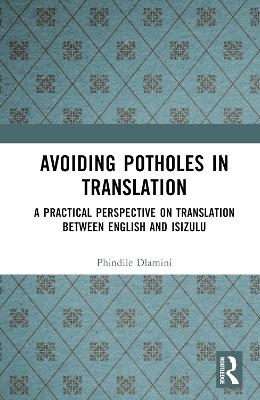
Avoiding Potholes in Translation
Routledge (Verlag)
978-1-032-63225-4 (ISBN)
This book is a comprehensive introduction to translation studies between English and isiZulu. It incorporates crucial concepts for understanding the basics of translation within a South African language context and lays a foundation for further studies in translation. The book's content coverage, while broad, is also in-depth, and it skillfully integrates examples from varied types of texts.
The practical and accessible style makes it both engaging and informative. The diverse examples illustrate not only the technicalities of translation as a process, but the vivid dynamics brought about by the fact that the languages involved in the translation process belong to different language families. The use of these examples for almost every aspect of translation explained makes this book unique and valuable to translation scholars and practitioners alike. Even though the book uses cases from the isiZulu language, it is an applicable reference for translation scholars and practitioners working with different indigenous languages of South Africa.
Print edition not for sale in Sub Saharan Africa.
Phindile MaMsomi Dlamini is lecturer at the University of KwaZulu-Natal and has authored more than 30 isiZuku children's books, some prescribed in schools around South Africa and others translated into English and isiXhosa.
Preface
Acknowledgements
Abbreviations
1 Introduction
1.1 Introduction
1.2 Translation around us
1.3 The concept of translation
1.4 The evolution of translation
1.4.1 Historical background of translation in South Africa
1.4.2 Theoretical perspectives
1.5 A guide to chapters
1.6 Conclusion
2 Key Elements in Translation
2.1 Introduction
2.2 Defining a text
2.2.1 Cohesion
2.2.2 Coherence
2.3 Understanding text analysis
2.3.1 Why analyse a text?
2.3.2 Reading for analysis
2.3.3 What type of text is this?
2.4 Subcategories of technical text types
2.5 Further categorisation of text types
2.5.1 Field of discourse
2.5.2 Tenor of discourse
2.5.3 Mode of discourse
2.6 Text functions
2.6.1 Informative function
2.6.2 Expressive function
2.6.3 Persuasive function
2.7 Translating for a different readership
2.8 Conclusion
3 Role-Players in the Translation Context
3.1 Introduction
3.2 The functional approach
3.3 Role-players in the translation context
3.3.1 The initiator
3.3.2 The translation brief
3.3.3 The translator
3.3.4 Analysing the source text
3.3.5 Stages of a translation task
3.3.6 The readership
3.3.7 Features of written language
3.4 Terminology lists and style guides
3.4.1 Dealing with terminology or technical terms
3.4.2 Terminology list
3.4.3 Developing a style guide
3.5 Conclusion
4 Defining and Exploring Translation Techniques
4.1 Introduction
4.2 Background to Vinay and Darbelnet’s work
4.3 The purpose of translation techniques
4.4 Outline of grammar used
4.4.1 Adverbs versus adverbials
4.4.2 English grammar
4.4.3 Challenges encountered
4.5 Two strategies, seven techniques
4.5.1 Direct translation strategies
4.5.2 Oblique translation strategies
4.6 Additional translation techniques
4.6.1 Amplification
4.6.2 Explicitation
4.6.3 Loss, gain and compensation
4.6.4 Generalisation
4.6.5 Simplification
4.6.6 Substitution
4.6.7 Omission
4.6.8 Implicitation
4.7 Conclusion
5 English Idiom Meets isiZulu Idiom
5.1 Introduction
5.2 Ideological factors
5.2.1 Terms of address
5.2.2 Proper nouns
5.2.3 Culture and cultural behaviour
5.2.4 Artwork
5.3 Poetological factors
5.3.1 Titles
5.3.2 Phraseology
5.3.3 Proverbs and idioms
5.3.4 Figures of speech
5.3.5 Grammar and syntax
5.4 Conclusion
6 Reflections on the Latest Trends in Translation
6.1 Introduction
6.2 Professional theory of translation
6.3 Risk in translation
6.3.1 The nature of risk in translation
6.3.2 Risk management for translation
6.4 Translation and culture (cultural turn)
6.5 Machine translation
6.5.1 Challenges in machine translation between English and isiZulu
6.5.2 Benefits of machine translation
6.6 Corpus-based translation studies
6.6.1 Corpus and corpus compilation
6.6.2 Corpus analysis tools
6.7 Conclusion
References
| Erscheinungsdatum | 12.12.2023 |
|---|---|
| Zusatzinfo | 16 Tables, black and white; 15 Halftones, black and white |
| Verlagsort | London |
| Sprache | englisch |
| Maße | 152 x 229 mm |
| Gewicht | 371 g |
| Themenwelt | Schulbuch / Wörterbuch ► Wörterbuch / Fremdsprachen |
| Geisteswissenschaften ► Sprach- / Literaturwissenschaft ► Sprachwissenschaft | |
| Sozialwissenschaften ► Soziologie ► Spezielle Soziologien | |
| ISBN-10 | 1-032-63225-9 / 1032632259 |
| ISBN-13 | 978-1-032-63225-4 / 9781032632254 |
| Zustand | Neuware |
| Informationen gemäß Produktsicherheitsverordnung (GPSR) | |
| Haben Sie eine Frage zum Produkt? |
aus dem Bereich


